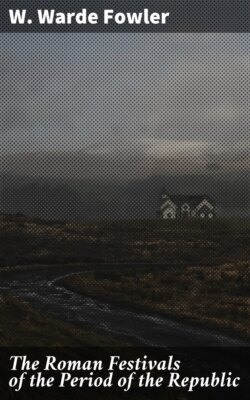Читать книгу The Roman Festivals of the Period of the Republic - W. Warde Fowler - Страница 36
На сайте Литреса книга снята с продажи.
Feriae Latinae.
ОглавлениеTable of Contents
A brief account may be here given of the great Latin festival which usually in historical times took place in April. Though it was not held at Rome, but on the Alban Mount, it was under the direct supervision of the Roman state, and was in reality a Roman festival. The consuls on their entrance upon office on the Ides of March had to fix and announce the date of it[348]; and when in 153 B.C. the day of entrance was changed to January 1, the date of the festival does not seem to have been changed to suit it. The consuls must be present themselves, leaving a praefectus urbi at Rome[349]; or in case of the compulsory absence of both consuls a dictator might be appointed Feriarum Latinarum causa. Only when the festival was over could they leave Rome for their provinces.
It was therefore a festival of the highest importance to the Roman state. But the ritual will show that it must in fact have been much older than that state as we know it in historical times; it was a common festival of the most ancient Latin communities[350], celebrated on the lofty hill which arose in their midst, where dwelt the great protecting deity of their race. At what date Rome became the presiding city at the festival we do not know. The foundation of the temple on the hill was ascribed to the Tarquinii, and this tradition seems to be borne out by the character of the foundations discovered there, which resemble those of the Capitoline temple[351]. No doubt the Tarquinii may have renovated the cult or even given it an extended significance; but the Roman presidency must conjecturally be placed still further back. Perhaps no festival, Greek or Roman, carries us over such a vast period of time as this; its features betray its origin in the pastoral age, and it continued in almost uninterrupted grandeur till the end of the third century A.D., or even later[352].
The ritual as known to us was as follows[353]. When the magistrates or (their deputies) of all the Latin cities taking part had assembled at the temple, the Roman consul offered a libation of milk, while the deputies from the other cities brought sheep, cheeses, or other such offerings. But the characteristic rite was the slaughter of a pure white heifer that had never felt the yoke. This sacrifice was the duty of the consul, who acted on behalf of the whole number of cities. When it was concluded, the flesh of the victim was divided amongst all the deputies and consumed by them. To be left out of this common meal, or sacrament, would be equivalent to being excluded from communion with the god and the Latin league, and the desire to obtain the allotted flesh is more than once alluded to[354]. A general festivity followed the sacrifice, while oscilla, or little puppets, were hung from the branches of trees as at the Paganalia[355]. As usual in Italy, the least oversight in the ceremony or evil omen made it necessary to begin it all over again; and this occasionally happened[356]. Lastly, during the festival there was a truce between all the cities, and it would seem that the alliance between Rome and the Latins was yearly renewed on the day of the Feriae[357].
Some of the leading characteristics of the Italian Jupiter will be considered further on[358]. But this festival may teach us that we are here in the presence of the oldest and finest religious conception of the Latin race, which yearly acknowledges its common kinship of blood and seals it by partaking in the common meal of a sacred victim, thus entering into communion with the god, the victim, and each other[359]. The offerings are characteristic rather of a pastoral than an agricultural age, and suggest an antiquity that is fully confirmed by the ancient utensils dug up on the Alban Mount[360]. As Helbig has pointed out, the absence of any mention of wine proves that the origin of the festival must be dated earlier than the introduction of the grape into Italy. The white victim may be a reminiscence of some primitive white breed of cattle. The common meal of the victim’s flesh is a survival from the age when cattle were sacred animals, and were never slain except on the solemn annual occasions when the clan renewed its kinship and its mutual obligations by a solemn sacrament[361].
As Rome absorbed Latium, so Jupiter Latiaris gave way before the great god of the Capitol, who is the symbol of the later victorious and imperial Rome; but the god of the Alban hill and his yearly festival continued to recall the early share of the Latins in the rise of their leading city, long after the population of their towns had been so terribly thinned that some of them could hardly find a surviving member to represent them at the festival and take their portion of the victim[362].
